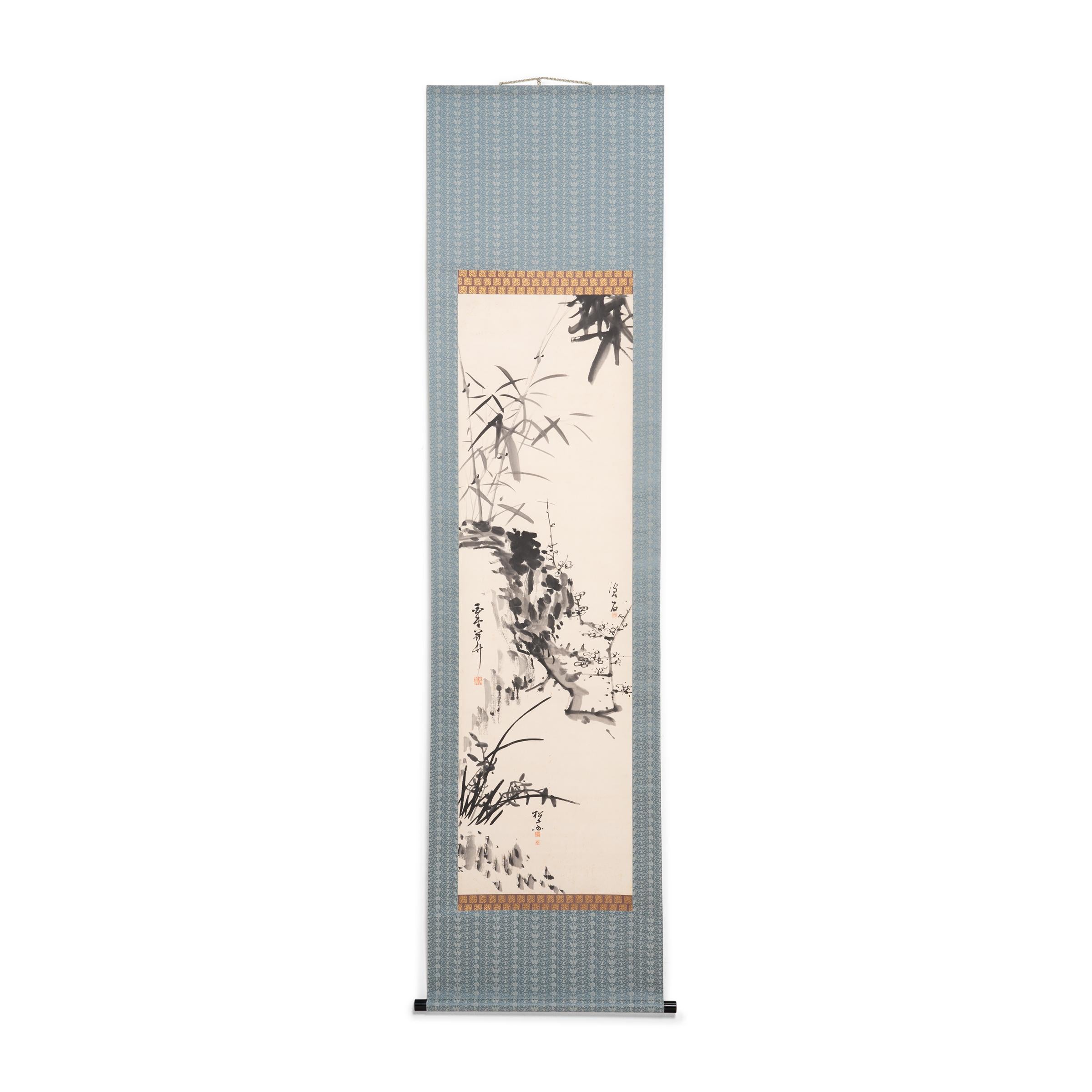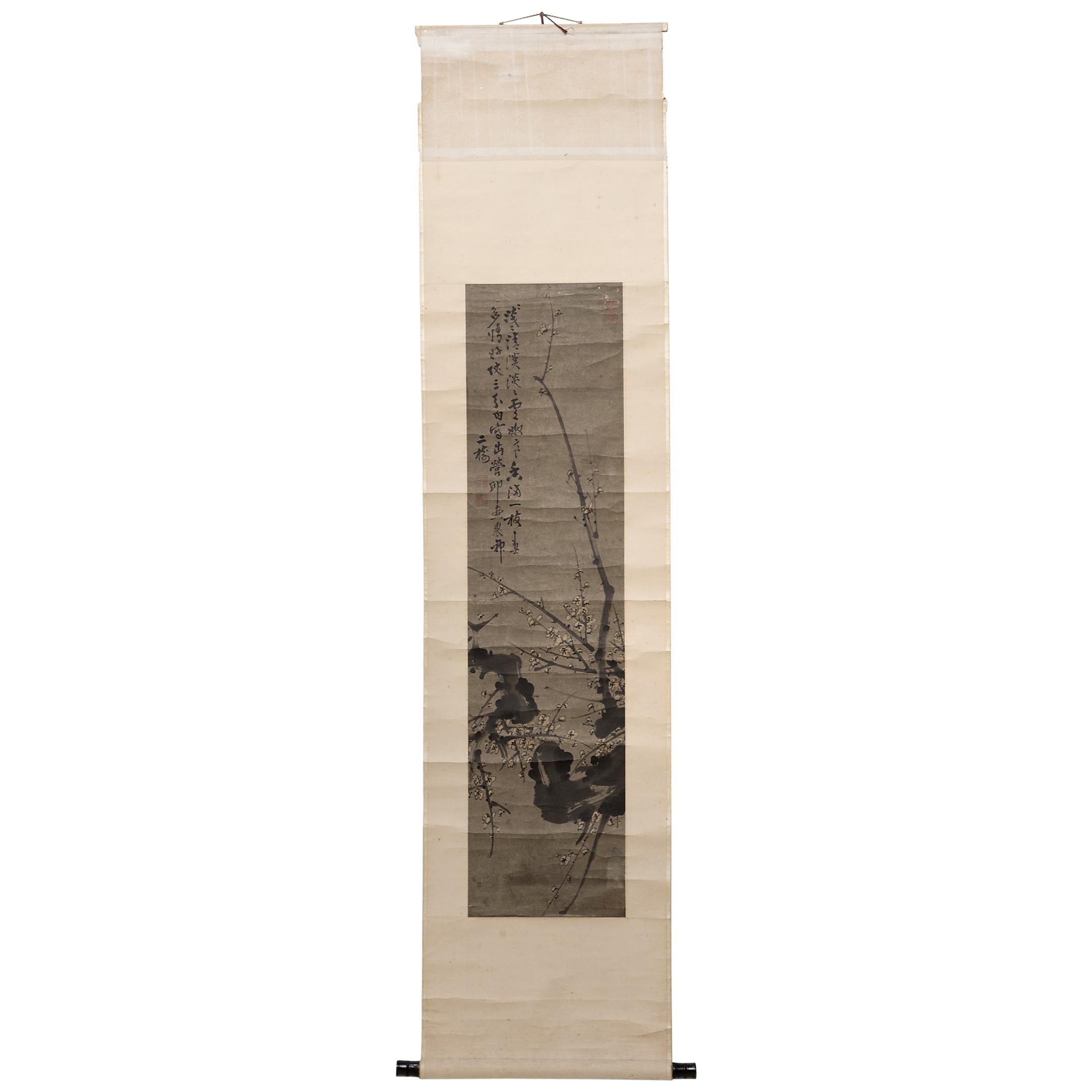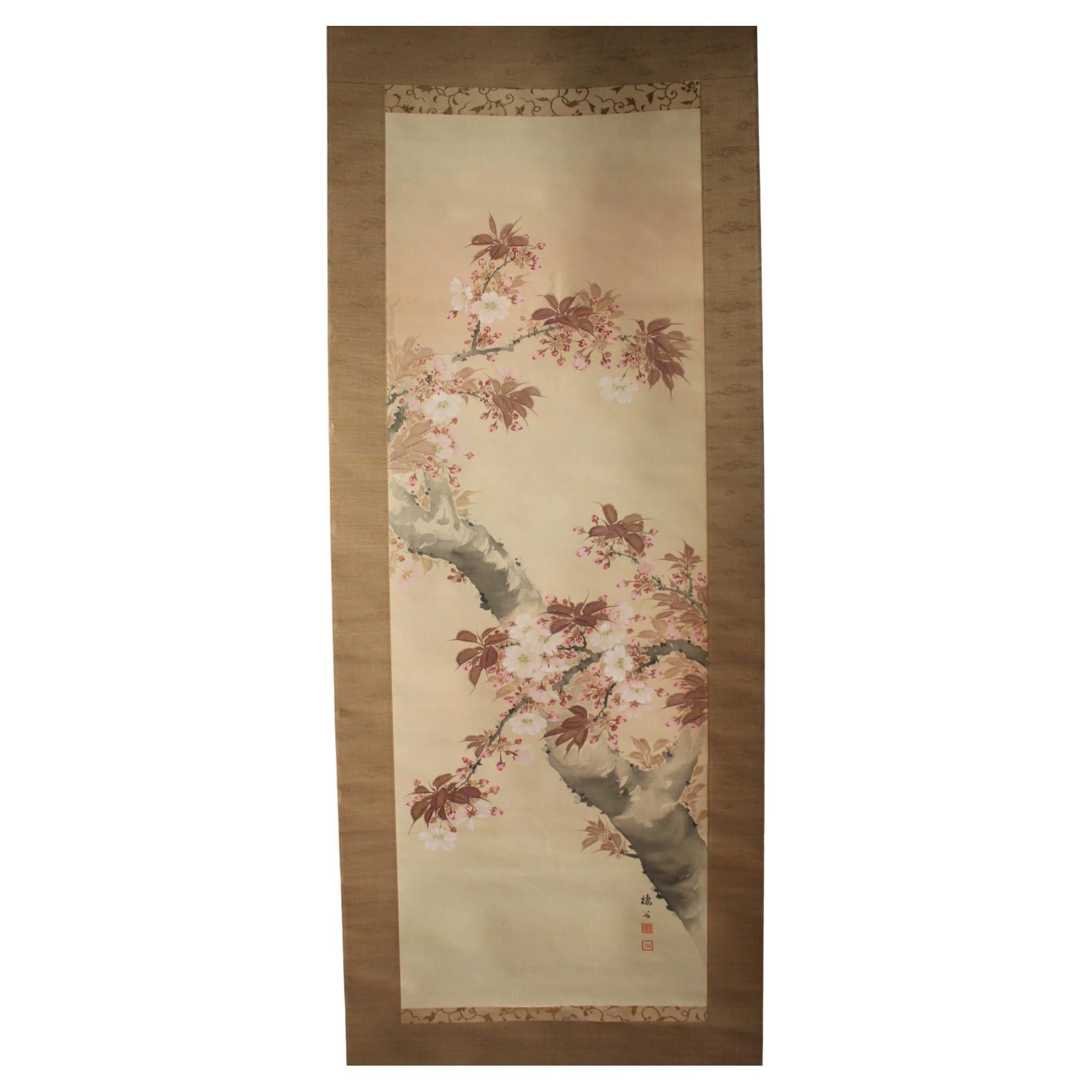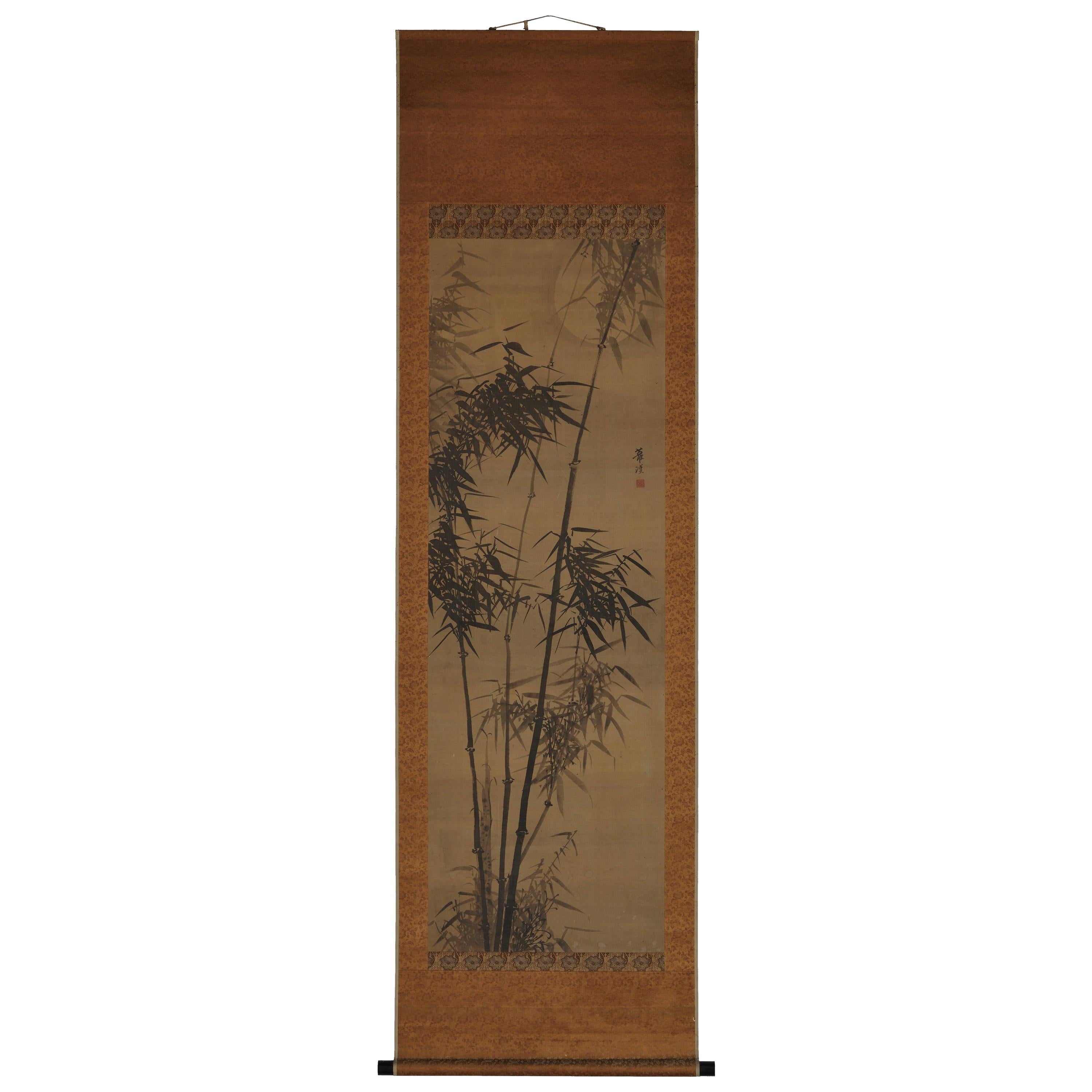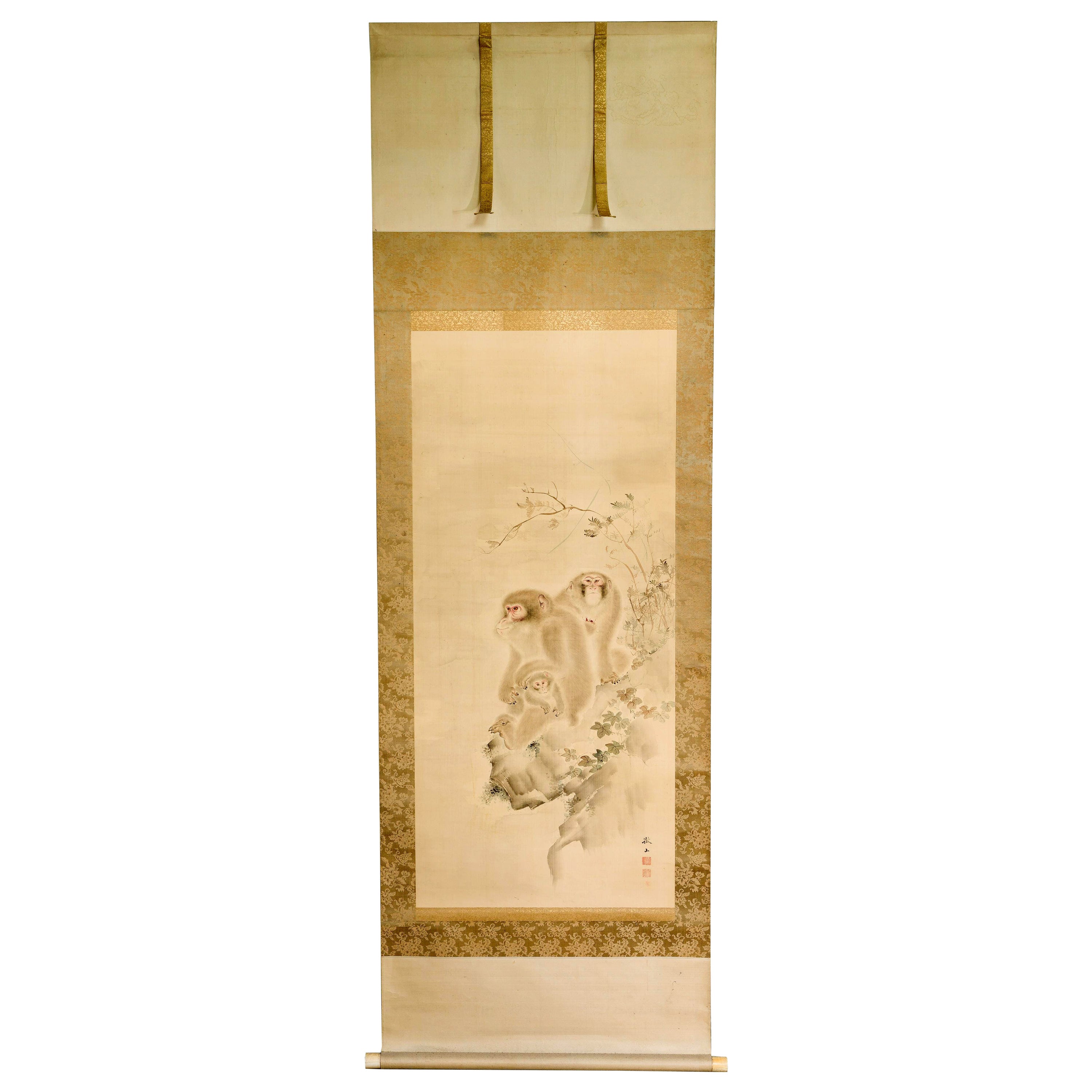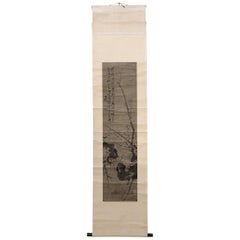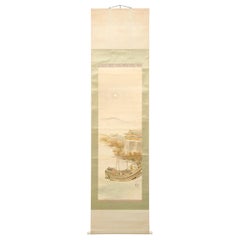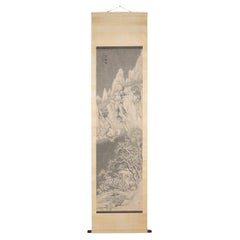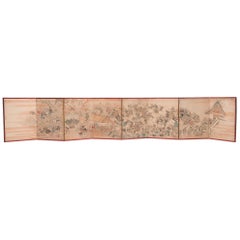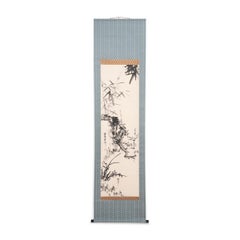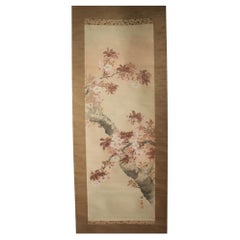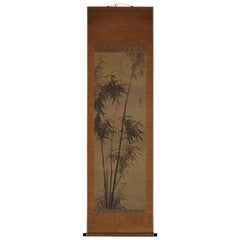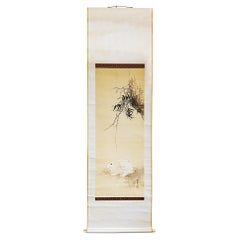Items Similar to Korean Hanging Scroll of Bamboo, Prunus and Orchids
Want more images or videos?
Request additional images or videos from the seller
1 of 6
Korean Hanging Scroll of Bamboo, Prunus and Orchids
$1,980
£1,503.97
€1,733.09
CA$2,788.33
A$3,091.28
CHF 1,624.59
MX$37,832.15
NOK 20,289.43
SEK 19,043.66
DKK 12,936.41
About the Item
This exquisite hanging scroll painting from the late 18th century depicts the sacred form of the bodhisattva Guanyin, known in Japanese Buddhism as Shō Kannon, or Guze Kannon. Described as the "Buddha of Infinite Compassion" or the “Goddess of Mercy,” Kannon is the embodiment of empathy and grace and makes herself available to all who call upon her with all their mind. Typically depicted as a woman in Chinese and Japanese art, Kannon can take many forms and is often invoked to encourage fertility or alleviate suffering.
This painted scroll depicts the goddess Kannon seated on a rocky outcropping in the middle of a churning ocean, surrounded by crashing waves and backed by swirling clouds and a large, moon-like halo. Exuding calm and elegance, she’s dressed in flowing robes and intricate jewelry and holds herself in a relaxed posture known as “royal ease.” Close attention to detail further enhances the beauty of her graceful form, such as the delicate shading of her face and the gilt linework of her robes, suggestive of silk embroidery.
With a serene expression on her face, Kannon casts a glance towards the two young children to her left, presenting her with an offering bowl filled with the “Pearls of Light.” These two figures are likely the goddess’s disciples Lung Nue and Shan Tsai, each of whom dedicated themselves to Kannon at a young age. Painted in a subdued palette of dark colors on woven silk, the painting is mounted on a silk brocade backing woven with full flower blossoms and trailing vines.
Gilt copper mounts reinforce the silk at either end.
- Dimensions:Height: 84.5 in (214.63 cm)Width: 21.5 in (54.61 cm)Depth: 1 in (2.54 cm)
- Materials and Techniques:
- Place of Origin:
- Period:
- Date of Manufacture:c. 1950
- Condition:Wear consistent with age and use.
- Seller Location:Chicago, IL
- Reference Number:Seller: CKJH0081stDibs: LU820038765122
About the Seller
5.0
Platinum Seller
Premium sellers with a 4.7+ rating and 24-hour response times
Established in 1997
1stDibs seller since 2006
1,710 sales on 1stDibs
Typical response time: 1 hour
- ShippingRetrieving quote...Shipping from: Chicago, IL
- Return Policy
Authenticity Guarantee
In the unlikely event there’s an issue with an item’s authenticity, contact us within 1 year for a full refund. DetailsMoney-Back Guarantee
If your item is not as described, is damaged in transit, or does not arrive, contact us within 7 days for a full refund. Details24-Hour Cancellation
You have a 24-hour grace period in which to reconsider your purchase, with no questions asked.Vetted Professional Sellers
Our world-class sellers must adhere to strict standards for service and quality, maintaining the integrity of our listings.Price-Match Guarantee
If you find that a seller listed the same item for a lower price elsewhere, we’ll match it.Trusted Global Delivery
Our best-in-class carrier network provides specialized shipping options worldwide, including custom delivery.More From This Seller
View AllChinese Hanging Scroll of Prunus Branches, circa 1850
Located in Chicago, IL
Chinese scholars used natural imagery and scenery to aid in contemplation within the walls of their studios. The complex beauty inherent to landscapes and natural forms inspired clea...
Category
Antique Mid-19th Century Chinese Qing Paintings and Screens
Materials
Paper
Japanese Meiji Riverside Scroll Painting, c. 1900
Located in Chicago, IL
Although western painting was initially embraced during Japan’s Meiji period (1868-1912), artists brought on a revival of traditional painting styles as they sought to create a modern Japanese style with roots in the past. This exquisite hanging scroll demonstrates the preference for soft layering of gray tones with judicious use of color. The landscape is rendered in soft ink washes that subtly distinguish between water, mountain, and sky. The scroll painting...
Category
Early 20th Century Japanese Meiji Paintings and Screens
Materials
Paper
Chinese Hanging Scroll Painting of a Winter Landscape
Located in Chicago, IL
Brushed with expressive linework and a minimalist color palette, this Chinese hanging scroll painting depicts an idyllic mountainside landscape in the ...
Category
20th Century Chinese Qing Paintings and Screens
Materials
Paper, Silk
Japanese Edo Period Festival Screen, c. 1750
Located in Chicago, IL
This 18th century folding screen is a stunning example of Japanese artistry. Beautifully painted with delicate brushwork, the evocative sc...
Category
Antique Mid-18th Century Japanese Edo Paintings and Screens
Materials
Paper
"Literary Gathering" Chinese Scroll Painting, c. 1923
Located in Chicago, IL
Exquisitely painted with delicate line work and a subdued color palette, this Chinese scroll painting is an Late 20th-century reproduction of a...
Category
Late 20th Century Chinese Paintings and Screens
Materials
Silk, Paper
Chinese Mythical Immortal Screen Painting, c. 1850
Located in Chicago, IL
Since the 12th century, people in China have used folding screens and doors to partition and decorate their homes - the vivid scenes backing the screens added life and color to a roo...
Category
Antique Mid-19th Century Chinese Paintings
Materials
Fabric, Paint
You May Also Like
Korean Hanging Scroll of Bamboo, Prunus, and Orchids
Located in Chicago, IL
This Korean hanging scroll from the mid-20th century honors traditional calligraphy painting with delicate detail and a refined composition, thought to inspire clear and concise thinking. Expressing the beauty and resilience of nature’s flora, ink calligraphy artists traditionally select plants and flowers as the subjects of their works, each chosen for its auspicious meaning, literary resonance, or scholarly virtue.
This particular example depicts a quiet natural landscape of three plants growing side-by-side along a rocky hill. Strong bamboo stalks sway above a branch of delicate prunus branches, while elegant orchids blossom in the foreground. Each painted by a different artist, these sacred plants represent the cycle of the seasons: the plum blossom for winter, the orchid for spring, and the bamboo for summer. Brushed with black ink for a monochromatic expression, the painting relies on value rather than color to convey depth and texture within this simple setting. The collaborative painting is contrasted by a beautiful blue silk brocade border woven with a repeating pattern of blossoms and vines.
Each plant is signed individually in ink along with the artist’s seal.
Painting has been remounted. Includes a wooden scroll...
Category
Mid-20th Century Folk Art Landscape Drawings and Watercolors
Materials
Silk, Paper, Ink
K10 Japanese Antiques Hanging scroll, Cherry blossom painting, silk
Located in Niiza, JP
Cherry blossom painting
Silk Scroll tip: wood
Image size: 410 (W) x 1200 (H) [mm]
Scroll mounting: 570 (W) x 2180 (H) [mm]
Box size: 80 x 75 x 700 mm 970g
Comes with a box, although...
Category
Antique 19th Century Japanese Paintings and Screens
Materials
Silk
Japanese Painting, Hanging Scroll, 19th Century Bamboo in Moonlight
Located in Kyoto, JP
Bamboo in moonlight
Gamo Rakan (1784-1866)
Hanging scroll, ink on silk.
Dimensions:
Scroll: 201 cm x 58 cm
Image: 137 cm x 45 cm
In this early 19th century work by Gamo Rakan a light ink wash applied to the silk background silhouettes the moon and suggests the atmosphere of early evening. Even though it is a literati subject, Rakan’s bamboo is quite realistic with a strong decorative style. The painting finds its inspiration from Chinese Ming dynasty painters who often used a single-tone, jet black stroke to emphasize the calligraphic nature of bamboo.
In a different era, decorative would have been seen as somewhat unrefined. But increasingly in the Edo period, it was the hallmark of high style. The Japanese people, in particular the rising merchant class, had gradually become apathetic toward the traditional Sesshu and Kano schools of painting. Chinese professional and amateur painters living in the port of Nagasaki during the 18th century had a profound effect on Japanese painting and the freshness of their style and its decorative appeal contributed greatly to its popularity. Gamo Rakan’s teacher, Tani Buncho...
Category
Antique Early 19th Century Japanese Edo Paintings and Screens
Materials
Silk
Japanese Hanging Scroll, Late 19th Century
Located in New York, NY
A Japanese hanging scroll or Kakejiku, circa 1890, depicting bamboo grass and a rabbit, framed by top and bottom ribbons of brocade silk.
In ...
Category
Antique 1890s Japanese Meiji Paintings
Materials
Silk, Paper
$2,624 Sale Price
20% Off
Japanese Silk Scroll Painting of Moneys Edo Period Mori Tetsuzan
Located in Atlanta, GA
A Japanese mounted vertical hanging scroll painting by Mori Tetsuzan (Japanese, 1775-1841) circa 19th century Edo period. The watercolor and ink on silk ...
Category
Antique 19th Century Japanese Japonisme Paintings and Screens
Materials
Silk, Paper
Hanging scroll : red camellia and birds
Located in Fukuoka, JP
Showa Period Japanese Hanging Scroll – Birds and Blossoming Flowers
This exquisite Japanese kakejiku (hanging scroll) from the Showa period (1926–1989) is meticulously hand-painted ...
Category
20th Century Japanese Paintings and Screens
Materials
Silk, Wood, Paper
More Ways To Browse
Scroll Painting
Hanging Scrolls
Vintage Asian Jewelry
Offering Bowl
Japanese Art Ocean
Retro Korean Furniture
Bamboo Screen Mid Century
Bamboo Scrolls
Japanese Scroll Flower
Asian Goddess
Chinese Silk Brocade
Vintage Bamboo Screen
Chinese Silk Scroll
Japanned Copper Light
Asian Painted Scrolls
Japanese Hanging Light
Cloud Bowl
Japanese Silk Screen Flowers
